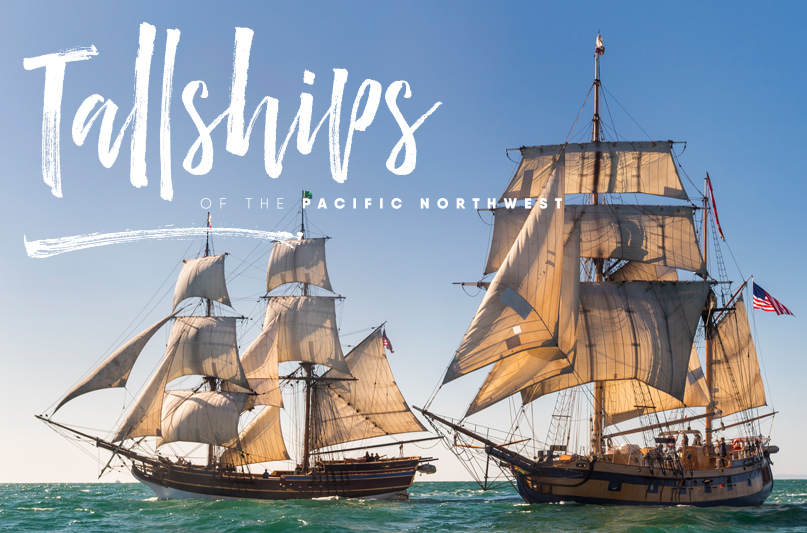
 If you find a good vantage point over the Salish Sea on a clear afternoon, you’re going to see just about every kind of vessel out there. Both recreational and commercial meld together in the Pacific Northwest, with hotshot racing sailboats making way for working fishing vessels and opulent motoryachts sharing the road with stout-hearted tugboats on the job. If your timing is good, you may catch a glimpse of one of the area’s beloved tall ships flying thousands of square feet of sail and manned by dozens of singing all-volunteer crews.
If you find a good vantage point over the Salish Sea on a clear afternoon, you’re going to see just about every kind of vessel out there. Both recreational and commercial meld together in the Pacific Northwest, with hotshot racing sailboats making way for working fishing vessels and opulent motoryachts sharing the road with stout-hearted tugboats on the job. If your timing is good, you may catch a glimpse of one of the area’s beloved tall ships flying thousands of square feet of sail and manned by dozens of singing all-volunteer crews.
Fortunately for us fans of sea salty beauty, the Pacific Northwest is home to several notable tall ships. Tall ships, broadly defined, are simply sailing ships with high masts, a most unsatisfactorily vague definition. Often rigged as topsail schooners, brigantines, brigs, or barques, surely we at Northwest Yachting can add an unofficial large size caveat to the definition. Additionally, it’s hard to imagine a tall ship without an element of historical design. Clearly, there are many large modern sailing yachts out there with tall masts to which the moniker tall ship doesn’t feel right. Like the superyachts vs. yacht vs. boat conversation, the tall ship vs. sailing yacht vs. sailboat discussion will probably forever be up for debate.
Tall ships treat the area as both homeport and port of call, livening up marinas and waterfront festivals wherever they sail. What is the Port Townsend Wooden Boat Festival (September 6 to 9) without the graceful presence of the locally based Adventuress?
One notable example of an exotic visitor was the Peruvian tall ship B.A.P. Unión to North Vancouver, British Columbia in May. Owned by the Peruvian government, this tall ship is one of the largest in the world at 517’ length overall and serves as a training ship for naval cadets from Peru and cooperating nations. B.A.P. Unión’s visit was to commemorate 75 years of diplomatic relations between the two countries.
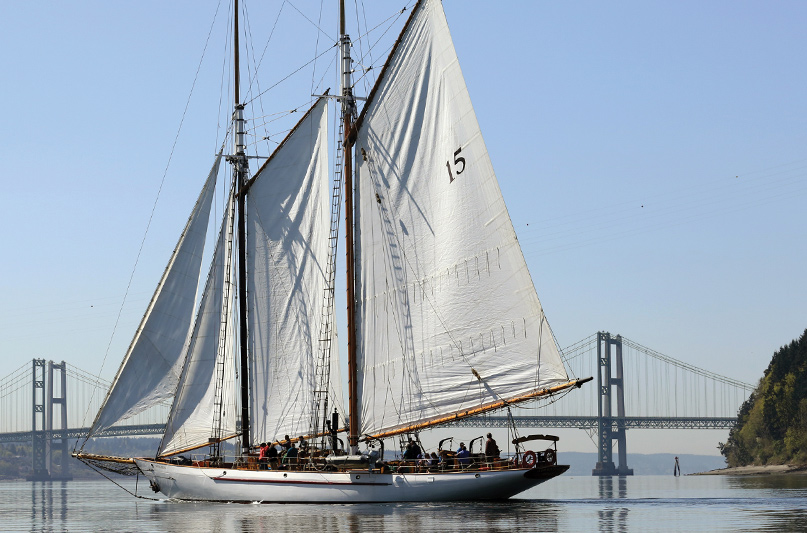
The lives of modern tall ships are often the most fascinating of any vessel on the water, as each tall ship represents an epic labor of love involving characters completely devoted to keeping their charge afloat, often on an all-volunteer basis. Even with a sound ship and crew of believers, each tall ship needs to pay the bills.
Some serve as charters and appear in movies, while others are lucky enough to exist under the umbrella of a well-funded nonprofit organization. Others spend most of their time on the water as an educational platform exposing shiny-eyed visitors to the wonders of the Salish Sea or whipping the next generation of maritime professionals into shape. A few even eek out a living shipping cargo like the old days, a defiant scoff at the declaration that the Age of Sail is dead.
The bottom line? We should all feel blessed that our watery corner of the world is both homeport and port of call to these magnificent vessels. Included are brief intros to a few of the notable locals. Next time your friends behold one of these beautiful ships, let loose some Pacific Northwest tall ship knowledge that will have them really dropping their jaws.
The Adventuress is a special thread in the Puget Sound nautical tapestry. Launched in 1913 in East Boothbay, Maine, the Adventuress’ early career was that of exploration and discovery. The mission under Chicago businessman and owner John Borden II? To secure a bowhead whale specimen from the North Pacific Arctic for the American Museum of Natural History.
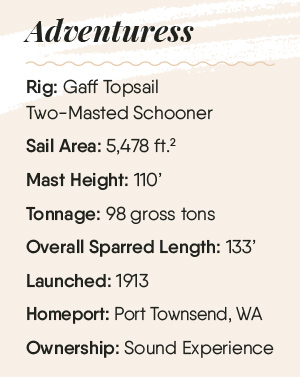 Roy Chapman Andrews—American adventure scientist who would discover the first dinosaur eggs in Mongolia and be the inspiration for Indiana Jones—was the naturalist aboard. Fortunately for the whales, the mission was unsuccessful in its primary pursuit. Adventuress was sold to the San Francisco bar pilots in 1914.
Roy Chapman Andrews—American adventure scientist who would discover the first dinosaur eggs in Mongolia and be the inspiration for Indiana Jones—was the naturalist aboard. Fortunately for the whales, the mission was unsuccessful in its primary pursuit. Adventuress was sold to the San Francisco bar pilots in 1914.
The decades wore on, and by the 1950s, Adventuress’ working pilot days were over. She was left to decay in Sausalito. Thankfully, Seattle entrepreneur and chandlery owner O.H. “Doc” Freeman found her and became a believer. He paid a paltry $7,800 for her and brought her home to Puget Sound. Adventuress changed hands many times afterward, notably becoming the passion project of a Girl Scouts of America troop that was pivotal in restoring her to her current glory.
Now a National Historic Landmark and under the auspices of 501(c)3 nonprofit Sound Experience, Adventuress serves as an educational platform with a mission to “educate, inspire, and empower an inclusive community to make a difference for the future of our marine environment.” A pillar of the nautical community in her own right, Washington State Governor Jay Inslee has been aboard, having declared her Puget Sound’s Environmental Tallship.
She underwent a major renovation this last year at Haven Boatworks of Port Townsend, Washington, that included a massive deck replacement. She’s back on the water now, doing what she does best; adventuring. Adventuress makes her way around Puget Sound during the summer for public events. You can learn more at soundexp.org.
The Aberdeen, Washington-built Lady Washington is a full-scale replica of the original namesake. What’s so special about the original that merits replicating?
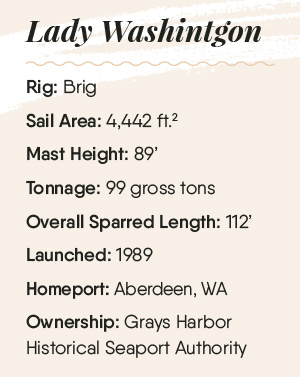 The original Lady Washington was a veteran of the Revolutionary War where she went toe-to-toe with the British. She was the first U.S.-flagged ship to make landfall on the West Coast of North America, Japan, Honolulu, and Hong Kong in the name of trade, ushering a new era in the Pacific. That a replica now plies our waters seems only appropriate, and she was launched with much fanfare as part of the 1989 Washington State Centennial celebration.
The original Lady Washington was a veteran of the Revolutionary War where she went toe-to-toe with the British. She was the first U.S.-flagged ship to make landfall on the West Coast of North America, Japan, Honolulu, and Hong Kong in the name of trade, ushering a new era in the Pacific. That a replica now plies our waters seems only appropriate, and she was launched with much fanfare as part of the 1989 Washington State Centennial celebration.
With a crew of 12, accommodations for 45 passengers, and twin 3-pounder swivel guns aft, this 112-foot brig has a legacy in Hollywood, including playing the role of the HMS Interceptor (the Admiral Norrington vessel hunting Captain Jack Sparrow) in the 2003 blockbuster Pirates of the Caribbean: The Curse of the Black Pearl.
Additionally, Lady Washington appeared in the TV series Star Trek Enterprise as the Enterprise (the nautical namesake for the famous fictional spaceship), in rapper Macklemore’s Can’t Hold Us music video, and more. When you combine the historical context with the modern influence, she is the official Tall Ship of Washington State for a reason.
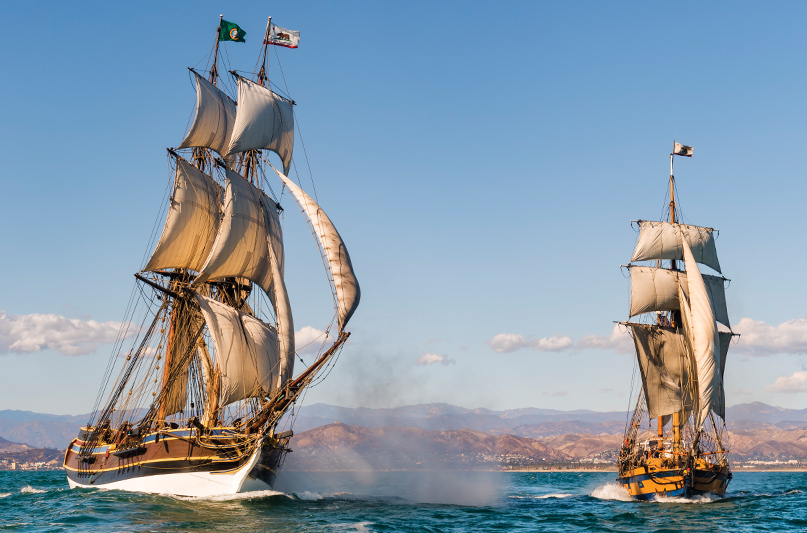
Owned and operated by the Grays Harbor Historical Seaport Authority, the Lady Washington’s mission is “to promote and preserve maritime history and traditions via hands-on educational opportunities.” She is regularly open to the public and available for private charter as she makes seasonal rounds to different ports in the area. See what Lady Washington is up to at historicalseaport.org.
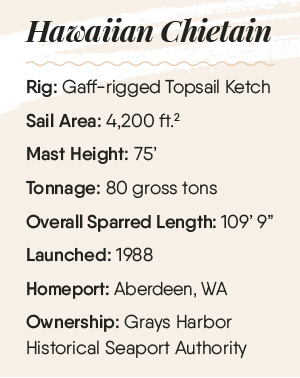 TThe Hawaiian Chieftain is a steel-hulled, gaff-rigged topsail ketch meant to emulate the early colonial and coastal packet-style vessels that once traded among the Hawaiian Islands. She was built by the Lahaina Welding Co. in Hawaii for the cavalier purpose of bringing back cargo trade via sail among the Hawaiian Islands. The shallow draft of 5’ 6” was meant to allow the Hawaiian Chieftain access to reef riddled moorages of the islands.
TThe Hawaiian Chieftain is a steel-hulled, gaff-rigged topsail ketch meant to emulate the early colonial and coastal packet-style vessels that once traded among the Hawaiian Islands. She was built by the Lahaina Welding Co. in Hawaii for the cavalier purpose of bringing back cargo trade via sail among the Hawaiian Islands. The shallow draft of 5’ 6” was meant to allow the Hawaiian Chieftain access to reef riddled moorages of the islands.
The sailing cargo industry must’ve been slim pickings, for the Hawaiian Chieftain changed hands several times over the years before the Grays Harbor Historical Seaport Authority gave her a forever home in 2005. The Lady Washington—already owned by the Authority—and Hawaiian Chieftain were well acquainted thanks to their previous rendezvous for mock battles in San Francisco Bay in the 1990s. These two battling “rivals” are now part of the same fleet.
Like the Lady Washington, the Hawaiian Chieftain is meant to “to promote and preserve maritime history and traditions via hands-on educational opportunities.” Often making her rounds with Lady Washington, the two transit from port to port for public events, hands-on educational offerings, and charters. More info can be found at historicalseaport.org.
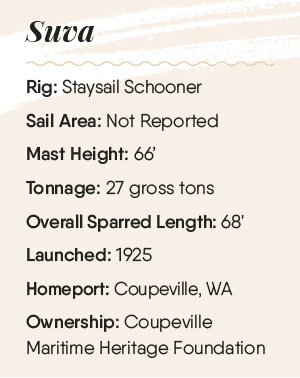 The most diminutive of the tall ships described here is the Suva, a 1925 pilothouse schooner designed by the one and only L.E. (Ted) Geary of Seattle. Built of old growth Burmese teak by shipbuilder Quan Lee in Hong Kong, Suva was shipped over the Pacific for Coupeville, Washington, resident Frank Pratt.
The most diminutive of the tall ships described here is the Suva, a 1925 pilothouse schooner designed by the one and only L.E. (Ted) Geary of Seattle. Built of old growth Burmese teak by shipbuilder Quan Lee in Hong Kong, Suva was shipped over the Pacific for Coupeville, Washington, resident Frank Pratt.
Now owned by the nonprofit Coupeville Maritime Heritage Foundation, the Suva is manned by volunteer crew, captains, docents, and maintenance workers. You can often see her on the Coupeville pier where she takes out guests.
Suva is the capital of Fiji, and reportedly Pratt named the vessel in homage to the country and his time working for the British government there. You can even find a Pratt Street in Suva, Fiji, which is thought to be named after him.
Northwest Yachting reported the re-launch of the Suva in its May 2016 issue feature, The Return of Suva. Captain Mark Saia—the founding member of the Coupeville Maritime Heritage Foundation and a Tai Chi master—is the man to thank. At the time, Suva was preparing for her first summer with clients aboard. We’re happy to report that she’s been sailing every summer since, including this one.
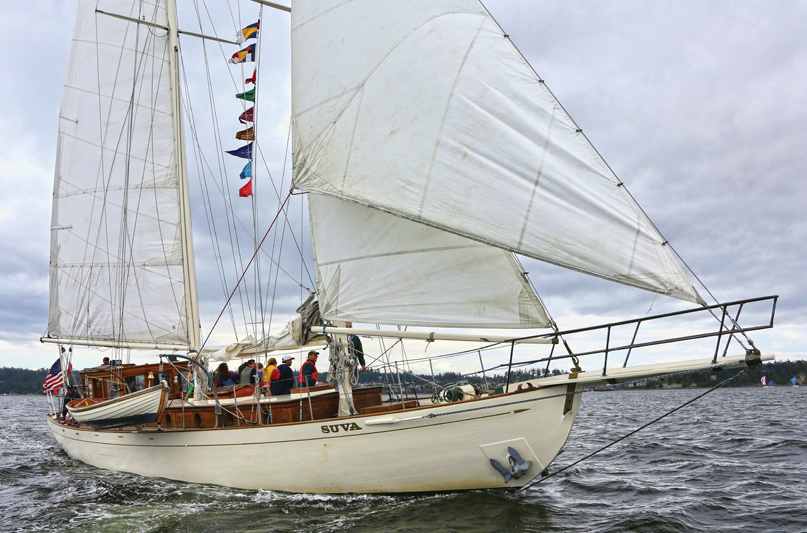
“The future will be having her in Coupeville for the next generation of Coupeville residents, guests, and aspiring sailors,” said Captain Saia at the time. Clearly, his and the Foundation’s support of the Suva is succeeding. Suva serves as the island’s de facto historic tall ship in a modestly sized package. Suva also crisscrosses Puget Sound to various waterfront festivals where she opens her decks to the public. You can learn more and plan a visit at schoonersuva.org.
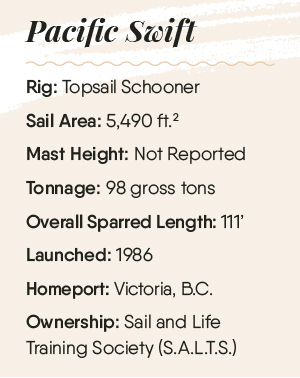 Built in a six-month period in 1985-1986 as part of an exhibition in the Expo 86 World Fair in Vancouver, B.C., Pacific Swift is one of the two tall ship replicas owned and operated by the educational nonprofit Sail and Life Training Society (S.A.L.T.S.). Pacific Swift is modelled in the style of a 1778-era brig named the Swift. The Swift was used by the Royal British Navy in the Great Lakes to oppose the uppity Yanks in confrontations leading up to the War of 1812.
Built in a six-month period in 1985-1986 as part of an exhibition in the Expo 86 World Fair in Vancouver, B.C., Pacific Swift is one of the two tall ship replicas owned and operated by the educational nonprofit Sail and Life Training Society (S.A.L.T.S.). Pacific Swift is modelled in the style of a 1778-era brig named the Swift. The Swift was used by the Royal British Navy in the Great Lakes to oppose the uppity Yanks in confrontations leading up to the War of 1812.
The Expo a success, Pacific Swift is often seen with her S.A.L.T.S.-owned sistership, Pacific Grace, to give young people hands-on educational and life experiences. Because of its size and safety the ship is considered an excellent training vessel. Youth groups are often aboard during the spring and fall for multi-day trips among the Gulf Islands, while summer trips tend to be longer. Pacific Swift sometimes goes further afield, with reported trips to ports of call in Australia, Europe, Galapagos Islands, East Island, and Pitcairn Islands.
The mission of S.A.L.T.S. is “training young people by the sea for life,” and that’s just what Pacific Swift is doing. You can keep tabs on her and plan a visit online at salts.ca.
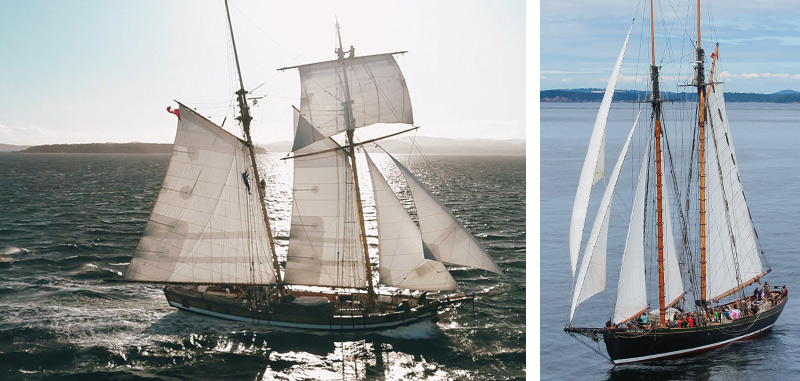
Pacific Grace is one of those tall ships a village is built around. A replica of the Robert II, one of the storied Canadian-built Grand Banks tall ship fleet that fished the North Atlantic, Pacific Grace is the passion project of S.A.L.T.S. based out of Victoria, B.C.
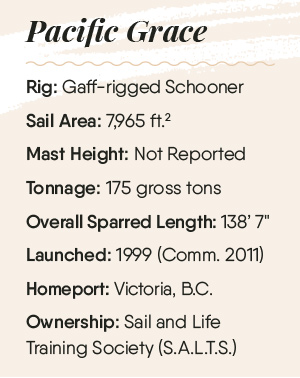 Built in the S.A.L.T.S. Heritage Shipyard with a hull of Nimpkish Valley Douglas fir and yellow cedar support beams, she is meant to be a consummate tall ship and daughter of Canada.
Built in the S.A.L.T.S. Heritage Shipyard with a hull of Nimpkish Valley Douglas fir and yellow cedar support beams, she is meant to be a consummate tall ship and daughter of Canada.
The Grand Banks tall ship design is one seared into the identity of Canada, not unlike the American Clipper ships of yore. This fame is in-part thanks to the famous Grand Banks-style Bluenose built in Nova Scotia. A gaff rig schooner who spent her life as a working fishing vessel in the North Atlantic and winning regattas in the off-season, bluenose is also a name for Nova Scotians. Dubbed Queen of the North Atlantic, she wrecked in 1946, a legend.
The S.A.L.T.S. mission is to give young people valuable educational and life experiences aboard. Like sister-ship Pacific Swift, youth hop aboard in the spring and fall for multi-day trips among the Gulf Islands, while the summer trips tend to be longer. Pacific Grace has been known to leave the Pacific Northwest, notably in 2007-2008 when she travelled to 15 countries in the South Pacific.
You can check out what Pacific Grace is up to, and research chances to climb aboard, online at salts.ca.
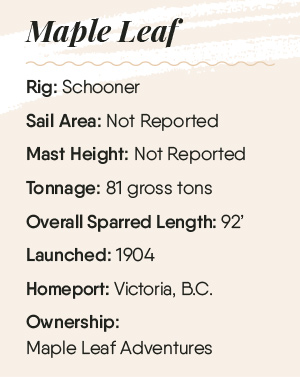 Maple Leaf is a point of Canadian pride and history in more ways than just the name. Built and designed by Canadian William Watts in 1904 in the Vancouver Shipyard of Coal Harbour, Maple Leaf was billed as the most expensive pleasure craft on the Pacific Coast. Owned by businessman Alexander MacLaren, she wore sail #1 at the Royal Vancouver Yacht Club and was the first ship north of San Francisco to have electric lights.
Maple Leaf is a point of Canadian pride and history in more ways than just the name. Built and designed by Canadian William Watts in 1904 in the Vancouver Shipyard of Coal Harbour, Maple Leaf was billed as the most expensive pleasure craft on the Pacific Coast. Owned by businessman Alexander MacLaren, she wore sail #1 at the Royal Vancouver Yacht Club and was the first ship north of San Francisco to have electric lights.
Wartime drastically changed her luxury trajectory as her lead keel and brass were stripped for WWI and she was converted to a motor-powered halibut fishing vessel. WWII was also rough for Maple Leaf with a ban on building domestic ships, but her owner at the time went ahead with a rebuild anyway in 1943. She kept fishing for halibut in the Bering Sea for decades before new ownership in 1980 converted the ship back to her original sailing lines and employed Maple Leaf as an educational and charter vessel.
Since 2001, Maple Leaf and the current parent company, Maple Leaf Adventures, are owned by businessman and ecotourism enthusiast Kevin Smith. The ship has appeared in national magazines like National Geographic and Outside and won awards like the Parks Canada Sustainable Tourism Award in 2012. Now a successful private charter vessel, Maple Leaf takes clients to wild and remote areas up and down the Inside Passage from Alaska to B.C. You can learn more at mapleleafadventures.com.
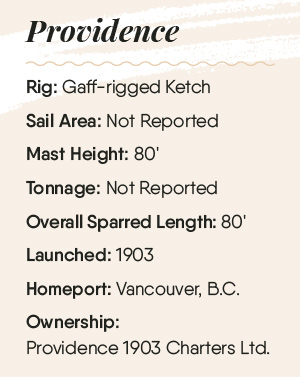 The tall ship Providence—originally Valkyrien—was built in 1903 in Denmark. The road to her current homeport of Vancouver, B.C., as a private charter vessel for both passengers and cargo is a full of twists.
The tall ship Providence—originally Valkyrien—was built in 1903 in Denmark. The road to her current homeport of Vancouver, B.C., as a private charter vessel for both passengers and cargo is a full of twists.
She started her life honestly enough as a fishing and cargo boat before the German Navy seized her during WWII. Fortunately, Germany was stopped, and the Danes took back their vessel in the aftermath of the war where she served in the Danish Navy for several years.
Ultimately, what would become Providence was sold by the Danish Navy and embraced a globetrotting lifestyle. The next several years saw many owners and odd jobs from its first refit in Vancouver, B.C., in 1979 into a power vessel, hauling cargo in the Caribbean, working in the Canadian fishing industry, and steaming as a private charter vessel.
Ultimately, Providence was sold to current owners Simon Fawkes and Danny Robertson, who put the vessel through an intensive eight-month refit that returned her back to sailing shape. Providence Charters Ltd. was launched and, as of summer 2019, offers charters for passengers and proudly provides carbon-emissions-free cargo shipping between the Gulf Islands. “You fill it, we ship it!” they tout on their website. See more at providence1903.com.
